

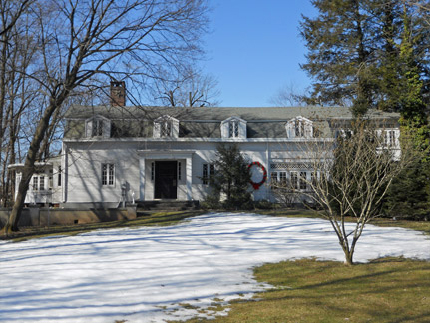
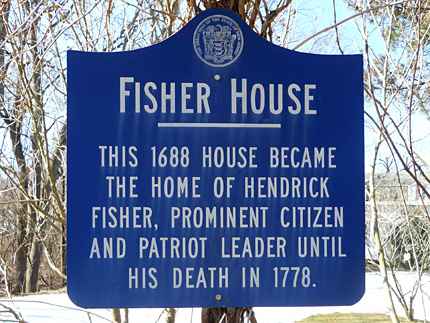
Hendrick Fisher Homestead
1960 Easton Ave.
Map / Directions to the Fisher House
Map / Directions to all Franklin Township Revolutionary War Sites
The Fisher homestead is now the property of the
Ukrainian Orthodox Church
and is located on the grounds of the St. Andrew Center.
For more information, contact The Ukrainian Orthodox Church
The oldest portion of this house was built in 1688, and it is most likely Somerset County's oldest standing structure. It was the home of Hendrick Fisher, who was born Hendrick Visscher, Jr. in Germany in 1697. His family immigrated to New Jersey circa 1703, and their name, Visscher, was anglicized to Fisher. In the decades before the Revolutionary War, Hendrick was a prominent citizen who was active religiously and politically, serving for many years as a Deacon of the Dutch Reformed Church in New Brunswick, and as a member of the Colonial Assembly. [1]
Fisher was a strong supporter of the cause of Independence who served in several important political positions during the Revolutionary War era. In 1765 he was one of three representatives for New Jersey for the Stamp Act Congress. [2] In 1775 he served in the Provincial Congress of New Jersey, and was elected its president. [3] On July 7, 1776, just three days after the adoption of the Declaration of Independence, Fisher read the document to an enthusiastic crowd of local residents in front of the Frelinghuysen Tavern, located a mile and a half from here in Bound Brook. [4]
Fisher's support of the cause of Independence was recognized by the British. On November 30, 1776, British General William Howe issued a proclamation which offered "full and free pardon of all treasons and misprisions of treasons" to those who would swear an oath to "remain in a peaceable obedience to his Majesty, and will not take up arms, nor encourage others to take up arms, in opposition to his authority."
Fisher was one of four New Jersey men specifically excluded from this pardon offer, and he was named as an "arch-traitor." One of the other men was Abraham Staats, whose house is located a half-mile from here in South Bound Brook. [5]
The Fisher homestead was raided in April 1777 by British troops. They had hoped to capture Hendrick Fisher, but he was not at the house at the time. However, the soldiers did steal cattle, money and other items from the property. [6]
Hendrick Fisher is buried in the Fisher Family Burial Ground, a fenced-in section in the St. Andrew Ukrainian Orthodox Cemetery, which is located just north of the house. [7]
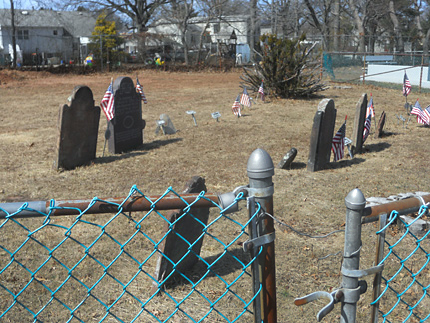
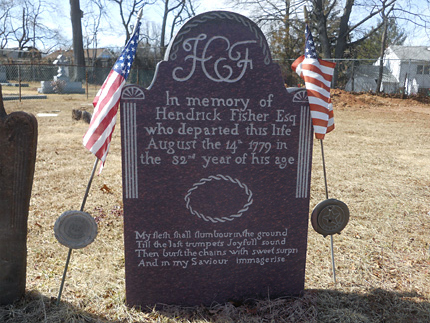

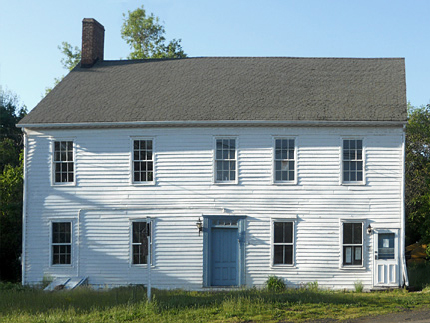
Franklin Inn/ Annie Van Liew's House
2371 Amwell Ave.
Map / Directions to the Franklin Inn
Map / Directions to all Franklin Township Revolutionary War Sites
The oldest part of this building was built circa 1752. It was the home of Cornelius and Ann Van Liew. The two had married in 1757 and were still living here at the start of the Revolutionary War.
Cornelius died January 29, 1777, and after his death, Ann continued to live here with their children.
At the time of the Revolutionary War, the house was much smaller. Additions were made to the house in the 1800s, and the building was made into a tavern known as the Franklin House or Franklin Hotel, and then later as the Franklin Inn. Much later, it was a used bookstore from 1992 until 2009. [8] The bookstore was closed in 2009 when the building was determined to be structurally unsafe. It is not currently open to the public.
From June 14 - 19, 1777, thousands of British and Hessian troops occupied this area. Some were encamped in Middlebush (now Franklin Township). The rest were encamped on the other side of the Millstone River in what is now Millstone, but was then part of Hillsborough. [9]
During that time, this house may have been used in some way by the occupying force. [10] Although the British burned down many houses when they left this area on June 19, this house was spared. [11] However, there may have been some damage or theft to the property during this time. [12] One of the houses which was not spared burning was the Garret Voorhees House, described in the entry below.
For more details about British / Hessian occupation of this area during the June 14 - 19, 1777,
see the Hillsborough Reformed Church and Cemetery entry on the Millstone page.

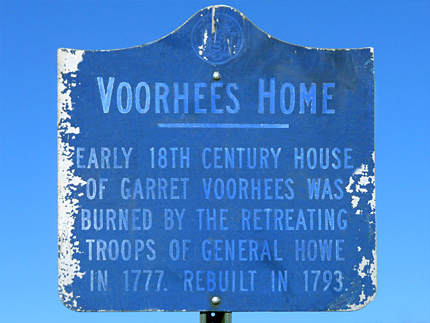
Garret Voorhees Home Site
1719 Amwell Rd.
Map / Directions to the Voorhees Home Site
Map / Directions to all Franklin Township Revolutionary War Sites
Garret Voorhees, Sr. was a supporter of the cause of Independence, and he served on the Committee of Correspondence. His son Garrett Jr. served in the military during the Revolutionary War. [13]
When General Cornwallis and his troops left the area on June 19, 1777, the Vorhees house was one of many houses that they burned between here and New Brunswick. [14]
In 1782, Garrett Sr. filed a claim for £451.17.8 for the loss of his property, which he was awarded by the New Jersey State Legislature. [15]
Garrett Sr. died in 1790. Three years later, Garrett Jr. built a new home on the property, using money which had been received in compensation for the home burned during the Revolution. [16] This second home still stands and is now the Stage Coach Tavern restaurant.

1. ^ Information drawn from:
• Fisher House page of The Ukrainian Orthodox Church website
• A. Van Doren Honeyman, "Hendrick Fisher - The Real German-American," Somerset County Historical Quarterly, Volume 8, Number 1, January 1919
Available to be read at Google Books here2. ^ The Journal of the Stamp Act Congress lists Hendrick Fisher as one of the three delegates from New Jersey. The other two delegates were Joseph Borden and Robert Ogden. Reprinted in:
C. A. Weslager, The Stamp Act Congress (Newark, Delaware: University of Delaware Press, 1976) page 1893. ^ Extracts from the Journal of Proceedings of the Provincial Congress of New Jersey: Held at Trenton in the Months of May, June and August, 1775 Pages 3-5 Available to be read at Google Books here
4. ^ See the Frelinghuysen Tavern Site entry on the Bound Brook page of this website.
5. ^ The full text of Howe's November 30, 1776 proclamation is reprinted in:
The Annual Register, or a View of the History, Politics, and Literature, For the Year 1777. The Fifth Edition (London: J. Seeley of Buckingham, and J. Wright, of St. John's Square, 1805) pages 295-296
Available to be read at Google Books here
▸ While the text of the proclamation does not mention the exclusion of the "arch-traitors," the Fisher House page of The Ukrainian Orthodox Church website, A. Van Doren Honeyman's "Hendrick Fisher - The Real German-American" mention Fisher's exclusion from the offer of pardon.
• Frank P. Snell, History of Hunterdon and Somerset Counties, New Jersey (Philadelphia: Everts & Peck, 1881) page 649, states:
"Peter Harpending, Tobias Van Norden, Hendrick Fisher, and Abraham Staats were excepted as 'arch-traitors' when general amnesty was offered by the British in 1776." Available to be read at Google Books here6. ^ Same as source note #1
7. ^ Gravestones and markers at the Fisher Family Burial Ground in St. Andrew Ukrainian Orthodox Cemetery
8. ^ Information drawn from:
• William B. Brahms, Franklin Township, Somerset County, NJ: A History (Commissioned by the Franklin Township Public Library, 1998) pages 55, 134, 206-207, 492
• Historic American Buildings Survey, available as a PDF on the Library of Congress website here
9. ^ For more information and accompanying sources notes about the events of June 14 - 19, 1777, see the Hillsborough Reformed Church and Cemetery entry on the Millstone page.
10. ^ Although the Franklin Inn is sometimes described as having been Cornwallis' headquarters during June 14-19, 1777, this is unsupported by the three contemporary documents listed below. These sources establish that Cornwallis had his headquarters at Millstone, on the western side of the Millstone River, rather than the eastern side where the Franklin Inn is located.
However, it is very possible that the house was used for some other purpose by the occupying force during this period, because it was located right in the middle of the encampment.
• Captain Johann Ewald, Translated and edited by Joseph P. Tustin, Diary of the American War - A Hessian Journal (New Haven and London: Yale University Press, 1979) page 67
▸Page 67 shows a map of Hillsborough which is "believed to be the only contemporary map extant showing a part of General Howe's unsuccessful maneuver to lure Washington out of his strong positions into open warfare." There is a spot marked as Cornwallis' headquarters on the Hillsborough (Millstone) side of the river.
▸ ▸ Images of this map can be seen on the Bloomsburg University of Pennsylvania website here• "Road from Brunswick thro' Somerset to Van Vacter's Bridge." 1779 Map by Robert Erskine.
▸ This map, which was made in 1779, has a spot marked as General Howe's 1777 headquarters in Middlebush (Franklin Township), near the property of Garrett Vorhees. However, there is no spot marked Cornwallis' headquarters.
This map does not show the Hillsborough side of the Millstone River, where Ewald locates Cornwallis' headquarters.
▸ ▸ An image of this map can be seen on the NYU Digital Library Technology Services website here• John André, Major André's Journal (Tarrytown, New York: William Abbatt, 1930) page 26
▸ Within André's entry for June 14, 1777, he writes, "Lord Cornwallis, having exchanged a few shots with a flying party of the Rebels at ye Millstone (Hillsborough or Somerset Court House), repaired the Bridge which they had begun breaking down, and crossing the river hutted on the heights of the Western bank." [Emphasis added.]
▸ ▸Available to be read at the Hathi Trust Digital Library website here11. ^ Captain Johann Ewald, Translated and edited by Joseph P. Tustin, Diary of the American War - A Hessian Journal (New Haven and London: Yale University Press, 1979) page 64-67
▸ In his entry for June19th, Ewald writes:
"At daybreak on June 19th the English army marched back to the heights of New Brunswick, because General Howe found that Washington would not let himself be deceived... On this march all the plantation of the disloyal inhabitants, numbering perhaps some fifty persons, were sacrificed to fired and devastation."
(Note that Ewald was a Hessian officer fighting on the British side, so when he refers to "disloyal inhabitants" he means citizens who were pro-independence and so not loyal to the British.)12. ^ "Somerset County Losses in the Revolution," Somerset County Historical Quarterly, Vol I, No. 4, Somerville, NJ, October 1912, Pages 279-286
Available to be read at Google Books here
▸ Lists a claim made by Anne Liew for £277.6.9 damages during the Revolutionary War. However, it does not specify what these damages were, or at what time they occurred.13. ^ Information about the Revolutionary War records of Garrett Sr. and Jr. appears in the following sources.
The military information listed in these sources for Garrett Jr. is contradictory.Daughters of the American Revolution Genealogical Research System. (Last name for both is shown as "Van Voorhees")
• Garret Sr. is Ancestor # A119111
• Garrett Jr. is Ancestor # A119119
William S. Stryker, Official Register of the Officers and Men of New Jersey in the Revolutionary War (Trenton: Wm. T. Nicholson & Co., 1872) page 305
Available to be read at Google Books hereJean Winslow Coltrane, Lineage Book - National Society of the Daughters of the American Revolution, Volume LX (Washington, D.C., 1922) page 175
Available to be read at Google Books here14. ^ National Register of Historic Places Registration Form for Middlebush Village Historic District, page 25
Available as a PDF at the National Park Service website hereCaptain Johann Ewald, Translated and edited by Joseph P. Tustin, Diary of the American War - A Hessian Journal (New Haven and London: Yale University Press, 1979) page 65
▸ Ewald writes, " At daybreak on June 19th the English army marched back to the heights of New Brunswick, because General Howe found that Washington would not let himself be deceived... On this march all the plantation of the disloyal inhabitants, numbering perhaps some fifty persons, were sacrificed to fired and devastation."
▸ ▸ Note that Ewald was a Hessian officer fighting on the British side, so when he refers to "disloyal inhabitants" he means citizens who were pro-independence and so not loyal to the British.
15. ^ £451.17.8
"Somerset County Losses in the Revolution," Somerset County Historical Quarterly, Vol I, No. 4, Somerville, NJ, October 1912, Pages 279-286
Available to be read at Google Books here16. ^ William Brahms Franklin Township (From the Images of America series) (New Hampshire: Arcadia Publishing, 1997) p.64
I would like to thank Mary Nelson of the Bound Brook Memorial Library for taking the time to locate, scan, and send me copies of several documents which I used in researching Franklin Township.